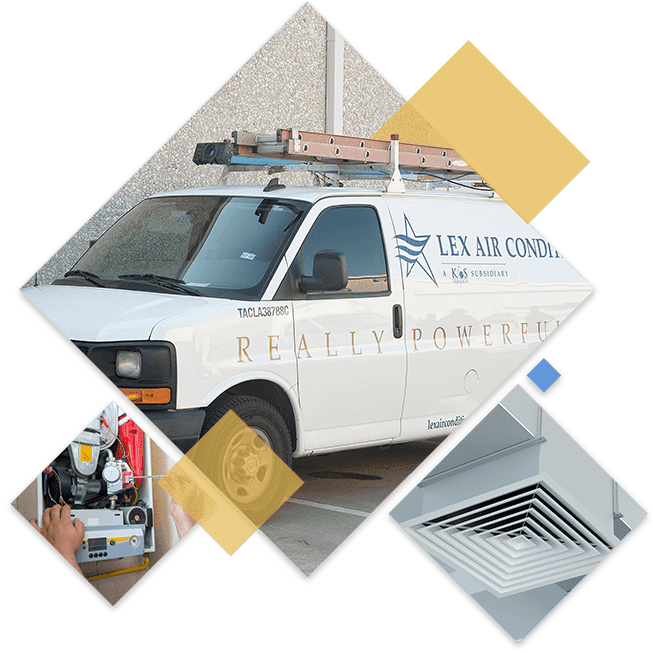Every aspect of our home environment can contribute to our health. Unfortunately, many are unaware of the potential health hazards lurking in their homes. These indoor environmental hazards can range from poor air quality due to inadequate ventilation to the presence of allergens and pollutants that can worsen existing medical conditions and cause respiratory health problems.
In this blog, the Carrollton indoor air quality specialists at Lex Air Conditioning & Heating explain the various health hazards that may be contributing to sick building syndrome and how you can improve your home’s environment. To schedule an indoor air quality consultation with one of our experienced HVAC technicians at Lex, give us a call at (972) 217-8955 today.
Is Your House Making You Sick?
Humidity levels, air, and home temperatures are crucial to our well-being. However, when poor ventilation combines with household chemicals, allergens, or other toxins, families can experience various health problems. Understanding the link between our home and our health is not just about creating a comfortable living space but a safe haven supporting and improving our overall health and well-being.
Indoor Air Quality and Its Importance
According to the Environmental Protection Agency (EPA), indoor air quality relates to the quality of air within homes and buildings, especially concerning the health and comfort of the structure’s occupants. The air within our homes, workplaces, and other indoor environments can often be more contaminated than outside air, even in urban areas like Carrollton. This can be a shock to many, as indoor environments are typically considered shelters from outdoor air pollution.
Since we spend a large amount of time indoors, it’s crucial to take air quality seriously. Poor IAQ can lead to short-term effects like irritation of the eyes, nose, and throat to more serious long-term consequences like respiratory diseases and asthma.

Indoor Air Issues That Might Be Making You Sick
Many unseen indoor pollutants can wreak havoc on a family’s health. Pollutants such as dust, pet dander, mold, and Volatile Organic Compounds (VOCs) can have serious adverse health effects if not addressed and managed effectively.
In addition to indoor pollutants, your home’s HVAC equipment can affect the air you breathe. A well-functioning HVAC system can efficiently filter pollutants and regulate humidity to create a healthier indoor environment. However, a neglected system can worsen air quality issues, causing family members to suffer from allergic reactions and other health issues.
Mold and Mildew
Mold and mildew, both fungi, are frequently found in moist and damp environments in homes and buildings. Visible mold, which can be black, green, or white, is often found in high-moisture areas such as kitchens and bathrooms. Mold growth is not just a visual concern but a health one, too, as it reproduces through tiny, airborne spores.
Mildew, on the other hand, is a white or gray powdery substance typically growing on damp surfaces, fabrics, or paper. While less harmful than mold, mildew can cause unpleasant odors and degrade materials it grows on.
Volatile Organic Compounds (VOCs)
Volatile Organic Compounds (VOCs) are chemicals that vaporize at room temperature and are commonly found in many indoor environments. They are emitted from various household products, including paints, cleaning supplies, building materials, furniture, and even air fresheners.
Short-term exposure to VOCs can lead to symptoms like headache, dizziness, and cold-like symptoms, while long-term exposure to VOCs has been linked to serious health conditions like liver and kidney damage and even cancer.

Dust and Dust Mites
Dust is a combination of particles, including human skin cells, fabric fibers, pet dander, and microscopic debris. Dust mites are tiny creatures that live in warm, humid environments and feed on organic matter in dust. Their waste products can worsen asthma and trigger respiratory symptoms like sneezing, runny nose, and sore throat.
Pet Dander
Pet dander, which is tiny, even microscopic, flecks of skin shed by cats, dogs, rodents, birds, and other animals with fur or feathers, is a common allergen found in homes with pets. These small particles can easily become airborne and linger indoors, settling on furniture, bedding, and carpets. For individuals with allergies or asthma, pet dander can trigger symptoms such as sneezing, nasal congestion, itchy eyes, or respiratory difficulties.
Pollen
Pollen is a powdery substance released by trees, grasses, and flowers. While it’s a common outdoor allergen, it often makes its way indoors, affecting indoor air quality. Pollen particles can enter indoor spaces through open doors and windows and can even be brought in on pets and clothing. These particles can trigger cold-like symptoms and be especially concerning for those with asthma and other respiratory problems. Pollen levels are usually higher in Carrollton during the spring and fall.
Carbon Monoxide (CO)
Carbon monoxide is a colorless, odorless gas that is a dangerous indoor pollutant. Household appliances like gas stoves and fireplaces can produce these hazardous fumes. Due to its invisible nature, carbon monoxide can accumulate to harmful levels in enclosed spaces without being detected, leading to symptoms like headaches and dizziness. It can even be fatal in extreme cases. Carbon monoxide detectors are essential in homes to promptly detect and alert residents to the presence of this hazardous gas.

Radon
Radon is a radioactive gas that is colorless, odorless, and tasteless, making it undetectable without specialized equipment. This naturally occurring gas can enter homes through cracks in floors, walls, and foundations.
Tobacco Smoke
Tobacco smoke is another indoor air pollutant, made up of over 7,000 chemicals, many of which are harmful and toxic. Secondhand tobacco smoke can lead to health issues, such as respiratory infections, asthma, heart disease, and lung cancer, even for non-smokers who live in the same environment. The smoke can linger in the air long after a cigarette has been extinguished and can settle on surfaces, creating residual contamination known as thirdhand smoke.
Pesticides
Many pesticides are made up of chemicals that can be dangerous to human health. Inhalation or skin contact with pesticides can lead to various health issues, including headaches, dizziness, nausea, and, in severe cases, more serious neurological and respiratory problems.
Lead Particles
Lead paint was commonly used in buildings before its ban in the late 1970s. As lead paint ages, it can deteriorate and flake off. When these lead particles are inhaled or ingested, they can cause lead poisoning, which is especially harmful to children. Lead poisoning can result in learning disabilities, developmental delays, and behavioral problems in children, while adults can suffer from kidney damage, high blood pressure, and other health complications.

Asbestos Fibers
Asbestos fibers, once commonly used in building materials for their durability and fire resistance, are now recognized as a significant health hazard. These tiny, durable fibers can become airborne if asbestos-containing materials are disturbed or damaged. When inhaled, asbestos fibers can become stuck in the lungs, leading to health issues such as asbestosis, lung cancer, and mesothelioma.
Bacteria and Viruses
Bacteria and viruses are tiny organisms that spread through the air, by person-to-person contact, or on surfaces. Common indoor spaces like kitchens, bathrooms, and areas with high human traffic are hotspots for these pathogens. Bacteria can cause various illnesses, from mild skin infections to more severe health conditions. Viruses like the flu or the common cold can easily increase in enclosed spaces, especially when ventilation is poor.
Signs Your House May Be Making You Sick
If you’re experiencing allergies, persistent headaches, chronic fatigue, or respiratory issues, it could be a sign that your house is making you sick. These symptoms are commonly associated with what’s known as “sick house” or “sick building syndrome,” a condition where the time spent in a specific building directly correlates with various health problems.
The high humidity levels in Carrollton can often lead to mold growth. This combination of humidity and allergens caused by the area’s high pollen counts can significantly contribute to poor indoor air and unhealthy living spaces.

DIY Indoor Air Testing Methods
Some simple, DIY air testing methods provide homeowners with a basic yet effective way to measure air quality. Simple strategies like monitoring humidity levels can be crucial; a hygrometer can help you keep tabs on this, as high humidity often fosters mold growth. For mold detection, visual inspections in prone areas like bathrooms and basements, along with over-the-counter mold test kits, can be initial steps.
Indoor air quality monitors are also valuable tools. These devices can track a range of pollutants, including VOCs, particulate matter, and even carbon monoxide levels. However, it’s important to recognize that while DIY methods provide a good starting point, they may not be as precise or comprehensive as professional assessments. They can miss certain contaminants or fail to provide a detailed analysis of pollutant levels.
How the Carrollton HVAC Professionals at Lex Air Can Help
For a more thorough understanding of your indoor air quality concerns, turn to the pros at Lex Air. Our air quality technicians will conduct a professional air quality assessment of your home to locate any underlying issues affecting your air. Following your IAQ assessment, your technician will offer recommendations to help you breathe easier.
Our indoor air quality services target specific concerns, like unbalanced moisture levels, air pollutants, and clogged air ducts. Air scrubbers effectively remove pollutants, while humidifiers and dehumidifiers balance the moisture levels, aiding comfort and preventing mold growth. Air duct cleaning also helps remove dust and allergens from your HVAC system.
Additionally, Lex Air provides comprehensive HVAC maintenance services that ensure your Carrollton heating and cooling systems operate efficiently throughout the year and adequately filter pollutants so you can breathe more easily.

How To Fight Back Against Poor Indoor Air Quality
To combat poor IAQ, there are several strategies you can introduce into your routines:
- Regular cleaning, including dusting and vacuuming, helps remove airborne particles and allergens from your home.
- Proper ventilation ensures that your home is well-ventilated to remove indoor pollutants. This can involve using exhaust fans, opening windows, and air purifiers.
- Regular maintenance of your HVAC system is also important when maintaining clean air. A well-maintained HVAC system plays an important role in circulating and filtering air.
- Homeowners also need to remember to replace air filters regularly. HEPA filters are recommended as they are the most effective in trapping fine particles.
Air Quality Issues? Call the Carrollton IAQ Specialists at Lex Today!
If you’re tired of your house making you and your family sick, call the indoor air quality experts at Lex ASAP! Our team is dedicated to ensuring your living space is filled with fresh air and free from pollutants and allergens.
From professional HVAC maintenance to installing advanced air purification systems, we are here to help you breathe easier. Call Lex Air Conditioning and Heating at (972) 217-8955 or contact us online today to take the first step towards a healthier home.












